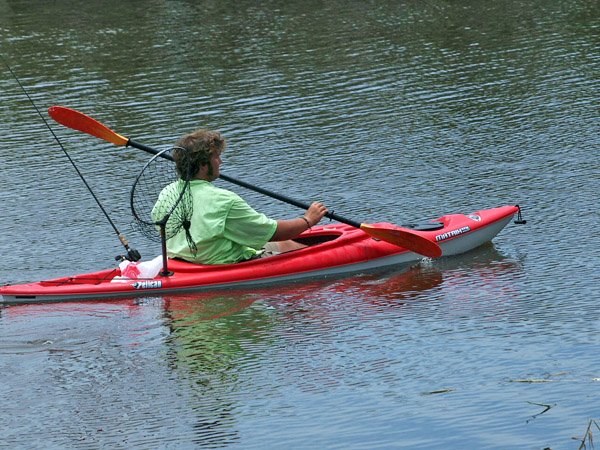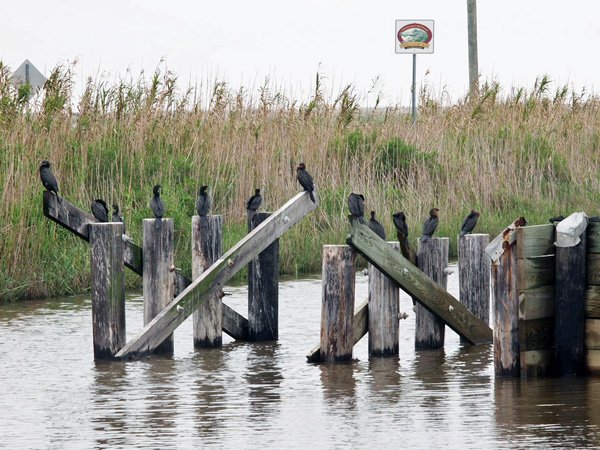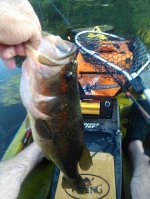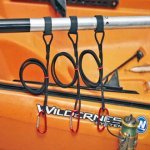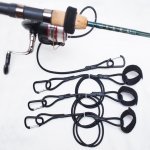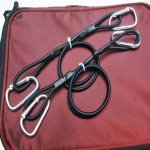The Terrible Deer Fly
- Plus -
An Easy Control Method
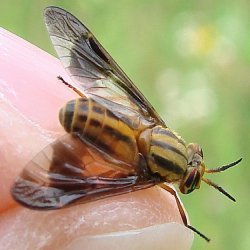
Oh, the dredded deer fly! If you have been attacked by deer flies, you know they need no introduction. They are horrible pests. These flies show no compassion on the unsuspecting person who crosses their path. A few flies can quickly become hundreds the longer you stay in the area. They are very fast and will attack mercilessly quickly ruining your fishing trip or a family outing. (Photo Courtesy of Bugguide.net)
It is largely believed there is no effective means of controlling these flies. However, one researcher has said to have found a simple way to keep them at bay. It is something the kayak fisherman can try and on my next trip to the Louisiana swamps I plan on employing this technique. I will explain it in detail later in the article.
What is a Deer Fly, You Ask??
Deer Flies are true biting flies and the
bites really hurt. Only the female bites. Females have small dagger like blades within their
mouth parts that slice the skin to draw blood. She then fills up on a blood meal. They are very aggressive.
The flies breed and live in
swamp and marsh locations. They also live in forests close to grassy
clearing or open areas. They can be found in most states.
My Personal Experiences with These Flies
One
of my favorite places in Louisiana is in the Sabine River Basin. It is
1000's of acres of marsh and swamp that is part of the National Wildlife
Refuge. The brackish waters are loaded with redfish, sea trout and
alligators. However, many parts are loaded with deer flies.
I spoke
to the kayak fisherman in the photo who had just paddled through a swarm
of deer flies - the same swarm that actually drove me away. He stated he
had been bitten, but didn't seem to be too alarmed by it. I suppose
there is not much you can do in a kayak surrounded by alligators
except to keep paddling. Some say it is possible to get used to deer flies,
but I don't imagine it to be easy.
Here is What I Have Learned About Them
Here is what I have learned about deer flies. First, they tend to reside in heavy congregations, but will not fly far to pursue a meal. Instead, they will wait until someone walks within a 100 or 200 ft of where they are waiting - then they swarm around you.
They pick up on exhaled carbon dioxide and move in quickly to the source. Deer flies love to bite around the head, arms, hands
and upper body.
To get away from them, all it usually takes is to move away from that 100 to 200 ft range they originated from and they will break off the attack. This is important to know. Only a few will follow for an extra 75 to 100 feet outside of that range.
All I had to do to get away from
them is to turn around and walk 100 ft or so and they were gone. Walk
back toward them and they will swarm again. Hopefully your favorite
places do not have infestation so close together. In those cases the only way to get
away from them is to leave the area.
Some claim they will not fly
into houses or cars, but that is not entirely correct. I am not sure
about houses, but I have certainly killed a few that have flown into my
car while I was stopped to photograph wildlife.
Methods
used to stop mosquitoes usually will not work on deer flies. Some
suggest using Deet, the strongest formula available, but is primarily
because they know of nothing else to suggest.
A Truly Interesting Cure to Your Deer Fly Problem
The following method was discovered by a University of Florida researcher:
Take a bright blue container - a small can, jug, metal coffee can, flower pot, or anything that can be mounted on a pole. I imagine you can paint it that color, but it has to be bright blue. I haven't seen a picture of the exact color used, so saying it needs to be bright blue or bright royal blue is all I know. The blue attracts the flies.
I read where a person had a bright blue car and every summer his car was covered with deer flies. He never knew why until someone told him it was the color. The article said he sold his car to end the problem.
Next, cover the bright blue container
with a sticky material, such as "Tanglefoot". Be sure it is
clear Tanglefoot and not the dark colored one. Tanglefoot is a super
sticky brush-on outdoor coating designed for this type of thing. The deer flies get stuck in the sticky goo and die.
The bright blue color is such a powerful attractant that people
nearby are not even bitten. Since there is only a finite number of deer flies in one location, you can temporarily
reduce the deer fly population to the point they are no longer a problem.
There
have been several deer fly tests by people from around the country using this
method and they all say it works great. I haven't personally tested it
and am only going off what others say, Where I live now there are no
deer flies. However, when I am back in Louisiana I will test it and
give you my personal opinion. I am hoping the reports are right and it
is an effective method of controlling the deer fly.
If you are kayaking in
thick deer fly territory be sure to bring your pole mounted blue jug coated with tanglefoot. Put the pole in a rod holder or somewhere on the
kayak so it extends several feet above you. This is exactly what I plan to do on my
next fishing trip to the swamps.
In the link I have provided, you
can also read about "trolling for flies" that has led to a decrease in
fly populations. it's worth a try.
Be sure to let me know how it works. I would love to hear about it.
Visitor Addition:
This comes from Parnell Ruiz. Thanks Parnell!
"Just wanted to add to your deer fly article. Blue is definitely the color. I keep blue plastic helmets and coat them in "tangle foot" but don't coat helmet brim. While walking in the forest on my property in WI, I don't get one bite. They do attack from behind and quickly fill the back of helmet, then I just put helmet on backwards till full. Use acetone to clean helmet and repeat. Working on some type of blue apparel for my dogs. Thanks for site."
Medical Entomology Information About Deer Flies
Zebco Reels Still Starting Fires in Young Fishermen
Zebco Reels are often the first reel a child uses. Read about how Zebco equipment got me started in a lifetime of fishing. The Biting Deer Fly to Hammerhead Kayak Supply Home
Copyright 2015-2025 Hammerhead Kayak Supply's Legal Information Our Privacy Policy and Terms of Use |
